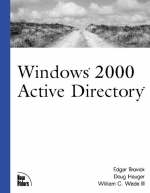
Windows 2000 Active Directory
Sams Publishing (Verlag)
978-0-7357-0870-9 (ISBN)
- Titel ist leider vergriffen;
keine Neuauflage - Artikel merken
Microsoft's Active Directory is a quantum leap forward in the management, interoperability, and security of your enterprise network. More that just an overview of the new features, Windows 2000 Active Directory helps you get the most out of this new tool's potential. Brovick, Hauger, and Wade will help you obviate pitfalls while giving you detailed solutions and pragmatic advice you won't find anywhere else. Perfect for network architects and implementers, this book describes the intricacies of Active Directory while keeping real-world systems and constraints in mind. If you are charged with planning, implementing, or managing Windows 2000, Windows 2000 Active Directory will help you: learn how to define your organization's business and technical requirements, and couple them with Active Directory's functionality; develop a unified directory strategy that will support enterprise applications now and in the future; and comprehend how Active Directory and DNS can coexist peacefully.
Edgar Brovick is the national director for Cambridge's Network Solutions Practice. Ed's experience started in development on a team creating an SNA PUT2 for NCR Systems. Most recently, Ed was a founding member of Excel Data's network services organization before its acquisition by Cambridge Technology Partners. Ed has a B.A. and M.S. in computer science, and he received his M.B.A. from the University of California, Irvine. Doug Hauger is the director of the Knowledge Management Group for Microsoft's Worldwide Enterprise Group. The Knowledge Management Group focuses on business uses of Microsoft's knowledge management solution in such areas as intranets, extranets, and the Internet by evangelizing both the technology and the methodology necessary to develop and deploy knowledge management solutions. Before joining Microsoft, Doug was Director of Technology at Cambridge Technology Partners, focusing on implementing Microsoft technology in large enterprise environments. Doug has worked extensively in the Middle East, and he will someday be drawn back there by his wife's career¿at which point, he will work harder than ever taking care of the home and children. Doug holds a B.A. from St. Olaf College and a M.A. from Boston University. William C. Wade III has been a networking and systems consultant for several years. From a big-six consulting firm, Bill's interests and talents lead him into the MCSE and MCT channels. Along the way, he worked for several solution providers, big and small, where he gained a great deal of experience implementing Microsoft solutions. Today, as an independent contractor available for hire, Bill works closely with Microsoft and other companies on Windows 2000 and Exchange 2000 projects. In his spare time, he writes articles, white papers, and books on new Microsoft technologies. Bill can be reached at bill@wadeware.net.
(NOTE: Each chapter concludes with a Summary.)
Introduction.
I. INTRODUCTION AND OVERVIEW.
1. How Active Directory Will Affect Your Organization.
The Customer-How Active Directory Affects the Users. Administration. Roles. Organizing and Evolving the Active Directory Team. Central Versus Distributed Administration. Small Organizations. Security. Infrastructure.
2. Introducing Active Directory.
Active Directory Components.
3. Active Directory as a Meta-Directory.
Defining a Meta-Directory. Integration with NetWare Directory Services. Integration with X.500.
4. Defining and Meeting Your Directory Requirements.
Defining Requirements. Mapping Requirements to Functionality.
5. Scoping the Project.
Analysis of Current Applications. Administrative Structure. Environmental Considerations. Staff.
II. PLANNING.
6. Planning for Coexistence.
Methodology and Process. Publisher and Subscriber Directories. Planning for Coexistence with NetWare. Planning for Coexistence with Windows NT 4.0. Planning for Coexistence with UNIX.
7. Designing the Windows 2000 Domain Structure.
Determining the Scope of Active Directory. Assessing Your Environment. Assessing the Administrative Structure. Assessing the Application Structure. Assessing the Organizational Structure. Weighing the Requirements. Defining Active Directory Namespace Candidates.
8. Designing the DNS Namespace.
Windows 2000 DNS: With Active Directory and Without Active Directory. Dynamic Host Configuration Protocol (DHCP) and DNS. DNS Standards that Support Active Directory. Microsoft DNS. Wadeware's DNS Implementation. Wadeware Uses Existing DNS.
9. Group Policies.
Windows NT 4.0 System Policy Capabilities. Group Policies. How to Administer Group Policies. Improving Performance on GPOs. How to Use Group Policy. Migrating Group Policy from Windows NT 4.0.
10. The Physical Topology: Sites and Replication.
Physical versus Logical Structure. Replication. Tools for Monitoring Replication. Sites Explained. Site Functionality Beyond Replication. Network Bandwidth. Site Design. Building Sites.
11. Active Directory and Scalability.
Growing a Domain. Growing a Tree. Growing a Forest. Growing with Your Organization. Growing with Your Applications.
III. IMPLEMENTATION.
12. Managing the Desktop.
Subsets of Enterprise Management. Windows 2000 Management Services. IntelliMirror. Microsoft Installer. System Management Server. Windows 2000 Remote Installation Services.
13. Developing an Administration Strategy.
Typical Windows NT 4.0 Administration Models. Windows 2000 Administrative Groups. Windows 2000 Administrative Strategies. Administrative Models for Windows 2000 Using Active Directory. OU-Specific Administration.
14. Windows 2000 Networking Services.
Windows 2000 Network Services. WINS. QoS.
15. Developing a Network Security Strategy.
Types of Security. Choosing the Right Security.
16. Developing a Remote Access Solution.
Remote Access Strategy. Remote Access Technologies. Access Methods and Standards. Secure RASs. Thin-Client Computing. Remote Access Considerations. Remote Access Policies.
17. Developing an Implementation Plan.
Implementation Plan in the Overall Project. Implementing Active Directory Design. Defining an Implementation Approach. Defining a Set of Implementation Tasks. Additional Implementation Plan Components. Managing the Implementation Project.
18. Windows 2000 and Exchange Server.
Exchange 5.5. Exchange 2000.
19. Scripting with Active Directory.
Benefits of Using Scripts. Creating a Simple Script. Testing the Script. Using LDIFDE Utility. Creating the Scripts. CSVDE Utility. Third-Party Tools.
20. Designing Active Directory Hierarchies.
Definition of a Hierarchy. When to Use OUs. When to Use Multiple Domains in a Single Tree. When to Use Multiple Trees. When to Use Multiple Forests.
21. Creating a Lab.
Building a Lab Team. Developing a Lab Strategy and Methodology. Creating a Test Lab Environment. Testing Hardware. Testing Software. Documenting Test Results. Presenting Lab Results.
22. Upgrading from Windows NT 4.0.
Reasons to Upgrade. Project Phases. Goals of the Migration. Preparing for the Migration and Active Directory. Approaches for Upgrading to Active Directory. Active Directory Upgrade Scenarios. When to Go to Native Mode.
Index.
| Erscheint lt. Verlag | 21.2.2000 |
|---|---|
| Verlagsort | Indianapolis |
| Sprache | englisch |
| Maße | 230 x 180 mm |
| Gewicht | 640 g |
| Themenwelt | Informatik ► Betriebssysteme / Server ► Windows |
| Informatik ► Betriebssysteme / Server ► Windows Server | |
| ISBN-10 | 0-7357-0870-3 / 0735708703 |
| ISBN-13 | 978-0-7357-0870-9 / 9780735708709 |
| Zustand | Neuware |
| Informationen gemäß Produktsicherheitsverordnung (GPSR) | |
| Haben Sie eine Frage zum Produkt? |
aus dem Bereich


